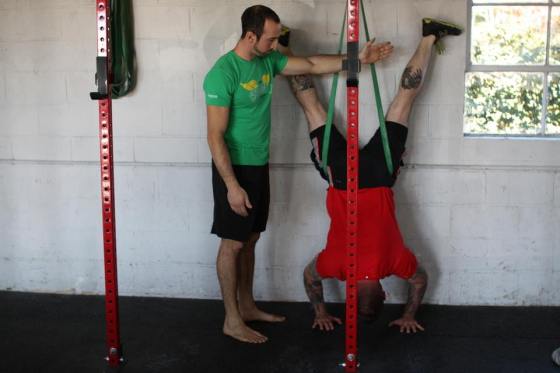Over the past few years my life has been split between fitness and music education. As such, I have spent a lot of time both instructing groups and taking group classes. It is crucially important for teachers and trainers to also be students every so often. You can almost always pick up on other ways of doing things that you can then bring back into your own practice.
For instance, I always begin my CrossFit classes with everyone stating their name to the group. Why? Because I have dropped in on many CrossFit gyms where no one knew each other’s name and the atmosphere was socially awkward! Another example is that I never ask a group a question such as, “So you all have already gone over ____ before, right?” Inevitably, no one wants to be the person to make the entire group go over a basic skill again. Rather, I work basic skills into the warm-up so that I know right then and there where everyone is at on that skill for the day.

Banded Headstand Push-up: One method I’ve learned to expose new or weaker athletes to inverted bodyweight pressing.
While observing a group exercise class the other day, I realized there is a need to quantify Instructional Efficacy. What do I mean by that? Please allow me to get a bit technical:
- Average Movement Quality (AMQ): In a group setting, the AMQ refers to how well each person is executing each skill. For instance, if 10 people are doing front squats, and 5 of them look rock solid while 5 of them have wobbly knees and elbows, then the AMQ is 50%. Similarly, if one person is doing power snatches with good positioning but consistently “presses it out” overhead, then perhaps we can say the AMQ is 33%.
- People: Total number of clients, athletes, students, attendees, etc.
- Instructors: Total number of trainers, coaches, teachers, assistants, group leaders, etc.
Using these three variables, we can then define Instructional Efficacy as:
- Instructional Efficacy (IE) = (AMQ x People) / Instructors
Important to note here is that while the Average Movement Quality is a subjective number, the number of People and Instructors is not. Therefore, as a gym owner, manager, or head trainer, your task should be to set clear standards for what counts as good Movement Quality and what does not. (The CrossFit Judges Course is a good place to start, although I think some of their standards are a bit questionable. Catalyst Athletics has a great resource of videos too.)
Let’s see this formula play out in a few different scenarios:
- CrossFit class with 2 instructors and 20 people doing power cleans. 5 athletes look good, 10 people could fix one small detail like stance width, and 5 newer clients need serious work on hip extension instead of arm bending. So let’s say the AMQ is 75%. Thus, the IE = (.75 x 20 people) / 2 instructors, or 7.5. If you only had one instructor, you’d have an IE of 15, and if you bumped it up to three instructors, then you’d get an IE of 5.
- Brazilian Jiu-Jitsu class with 1 instructor and 12 people practicing arm-bars. 3 blue belts have it down, 3 advanced white belts can do it but have trouble transitioning, and 6 newer white belts are really struggling. The black belt instructor deems the AMQ to be roughly 40%, and therefore the IE is 4.8. If he asks a blue belt to help the white belts and the AMQ raises to 90%, then the IE raises to 4.95.
- Personal training session with 1 client and 1 trainer discussing nutrition. Ah, a trick question! Well, if the client goes home and follows the trainer’s advice to eat mostly meat and vegetables, then the Instructional Efficacy is high. However, if the nutrition information goes in one ear and out the other, then it is the trainer who has some homework to do because their IE is low.
So how should you use this concept? Your goal should be to keep the Average Movement Quality, and thus the Instructional Efficacy, as high as possible. Whether you teach fitness, martial arts, music, or arts and crafts, your value as an instructor can be quantifiably measured based on the quality work done by your students.
Thanks for reading, and please share if you find this concept to be noteworthy!